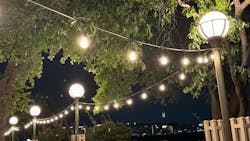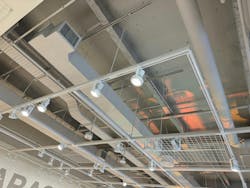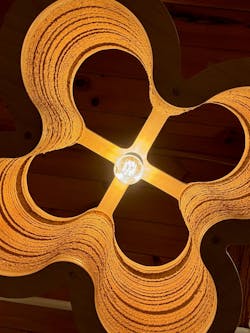The Apprentice’s Guide to Article 410
Note: This article references the 2017 NEC because the Philadelphia area — the jurisdiction where this author teaches and works— is still operating under that version of the Code.
One of the most important areas covered by the National Electrical Code (NEC) is the installation and selection of luminaires (aka “light fixtures”) — essential electrical equipment used in residential, commercial, and industrial lighting applications and systems. This handy article covers fixture type selection, terms associated with luminaires, location requirements for luminaires, and the pertinent aspects for the proper installation of temporary and permanent lighting, portable luminaires, lampholders, pendants, incandescent filament lamps, arc lamps, electric-discharge lamps, decorative lighting products, lighting accessories for seasonal and holiday use, portable flexible lighting products, and the wiring/equipment forming part of such products. Electrical apprentices should follow these guidelines to reduce service calls, failed inspections, and the painful process of redoing their installations. Remember: The boss only gets paid once.
Stick to these basic guidelines
Some guidelines may seem silly or common sense, but let’s not take anything for granted. All luminaires, lampholders, and retrofit kits are required to be “listed” [Sec. 410.6]. Listed means equipment, materials, or services that are included in a list published by an organization acceptable to the authority having jurisdiction.
Several laboratories test and label electrical equipment: Underwriters Laboratories (UL) is probably the most recognizable label. They maintain periodic inspection of production of listed equipment or materials or periodic evaluation of services, and whose listing states that either the equipment, material, or service meets appropriate designated standards or has been tested and found suitable for a “specified purpose.” Always use, select, and install luminaires and their associated parts designed for the specific application and environment you intend to use them in; be mindful that your choice of fixtures matters as the environment, temperature, and occupancy type changes.
“Wet” is not “damp”
For example, do not install light fixtures designed for indoor use “outside” — luminaires installed in wet locations shall be marked “Suitable for Wet Locations”; luminaires installed in damp locations shall be marked “Suitable for Damp Locations.” Pay close attention to when luminaires are needed in specific locations, and remember everything matters — the environment, temperature, and condition. Manufactured specifically for their application, luminaires installed in wet or damp locations shall be installed so water cannot enter or accumulate in wiring compartments, lampholders, or other electrical parts. As you begin to become savvier with interpreting and navigating the Code book, you must be able to differentiate the subtle differences and nuances between definitions. Here’s a perfect example from Art. 100:
Location, Damp. Locations protected from weather and not subject to saturation with water or other liquids but subject to moderate degrees of moisture.
Location, Wet. Installations underground or in concrete slabs or masonry in direct contact with the earth; in locations subject to saturation with water or other liquids, such as vehicle washing areas; and in unprotected locations exposed to the weather.
Luminaires must be listed for their use
Electricians are judged on their ability to stick to NEC guidelines, only deviating when necessary and guided by authority set by the AHJ, which we call “Special Permission.” Don’t install custom-designed light fixtures without checking with the building or electrical inspector first. Making the call to the underwriter first can save you a lot of headaches. You may need a UL listing approval on commercial job sites to install luminaires made by a boutique custom craft shop.
The labeling and listing process helps to ensure the safety and quality of electrical equipment and the people who use it. This means this equipment will have the imprint (usually either stamped or an adhesive label) with the logo of the testing laboratory and other pertinent information on each piece of equipment. Always read the manufacturer’s installation guidelines and search for the luminaires listing/labeling information. This will keep you informed, prepared for the installation process, and potentially reduce the liability or exposure to your company.
Luminaires for commercial and industrial environments
Luminaires installed in commercial cooking hoods (e.g., restaurants, vending trailers, etc.) must meet the following conditions:
- The luminaire shall be “identified” for use within commercial cooking hoods.
- Installed in such a manner that the temperature limits of the materials used are not exceeded.
- The luminaire shall be constructed so that all oil, grease, exhaust vapors, and cooking vapors are excluded or prevented from entering the lamp and wiring compartment.
The lighting diffusers shall be resistant to thermal shock. Parts of the luminaire exposed within the hood shall be corrosion resistant or protected against corrosion, and the surface shall be smooth so as not to collect deposits and facilitate cleaning. The luminaire shall be identified for use within commercial cooking hoods and installed so that the temperature limits of the materials used are not exceeded.
Fixtures installed in bathtub and shower areas
No parts of cord-connected luminaires, chain, cable, or cord-suspended luminaires, lighting track, pendants, or ceiling-suspended (paddle) fans shall be located within a zone measured 3 ft horizontally and 8 ft vertically from the top of the bathtub rim or shower stall threshold. This zone is all-encompassing and includes the space directly over the tub or shower stall. Luminaires located within the actual outside dimension of the bathtub or shower to a height of 8 ft vertically from the top of the bathtub rim or shower threshold shall be marked for damp locations or wet locations subject to shower spray.
General luminaire wiring and support
Per Sec. 410.48, wiring on or within luminaires shall be neatly arranged and not be exposed to physical damage. Excess wiring shall be avoided. Always remember Sec. 110.12, mechanical execution of work. Conductors shall be arranged so that they are not subjected to temperatures above those for which they are rated. Framing members of suspended ceiling systems used to support luminaires shall be securely fastened to each other and shall be securely attached to the building structure at appropriate intervals. Luminaires shall be securely fastened to the ceiling framing member by mechanical means, such as bolts, screws, or rivets. Listed clips identified for use with the type of ceiling framing member(s) and luminaire(s) shall also be permitted.
These are just a few of the important guidelines for installing luminaires, so make sure you familiarize yourself with all aspects of this pertinent Article.
Follow my column for more tips on applying electric basics concepts in the field, navigating the NEC, preparing for exams, and understanding how to apply Code guidelines in the field. Past columns include Everyday Instructions for Electricians, The Apprentices Guide to Special Equipment, The Apprentice’s Intro Guide to Motors, The Apprentice’s Guide to Service Entrance Cable, The Apprentice’s Guide to Informative Annex C, The Apprentice’s Guide to Success in the Electrical Construction Industry, and The Apprentice’s Guide to Article 404. For more information on why a structured approach is so important to navigating the NEC and how to put its requirements into practice in real-world settings, read “The NEC for Newbies.”
About the Author
Harold De Loach
De Loach is the Director of Education and Training for the Leaders of Electrical License Preparation courses for Philadelphia and The Lehigh Valley (www.necprepclass.com). He is the founder and Director of The Academy of Industrial Arts L.L.C. (www.taia-school.com), a customized electrician training program that provides entry-level electrician training courses, electrical safety classes and customized electrical construction courses. He is trained by the National Center for Construction Education and Research (NCCER). He is a member of The National Society of Collegiate Scholars, the Independent Association of Electrical Inspectors, the Electrical Association of Philadelphia, and the Better Business Bureau.
His level of knowledge affords him to teach entry, intermediate, and master level electricians. Armed with more than 20 years of experience in the electrical, general construction, and real estate development industry, he offers his students and clients several unique skill sets. He has worked as the Head Craft Instructor and Assistant Director of Education at the Apprenticeship Training Center (affectionately known as The ABC School) in Harleysville Pennsylvania for Associated Builders and Contractors (The South-Eastern Pa. Chapter). Prior to Joining ABC, he directed a work-readiness (Re-Entry) Construction Technology program within The Philadelphia Prison System and as an Electrical Technician Program instructor at Kaplan Career Institute (Formerly Thompson institute) in Center City Philadelphia and Franklin Mills. He is available for consultation, private tutoring, speaking engagements, or strategic partnerships that can bolster the number of new electricians entering the industry.




